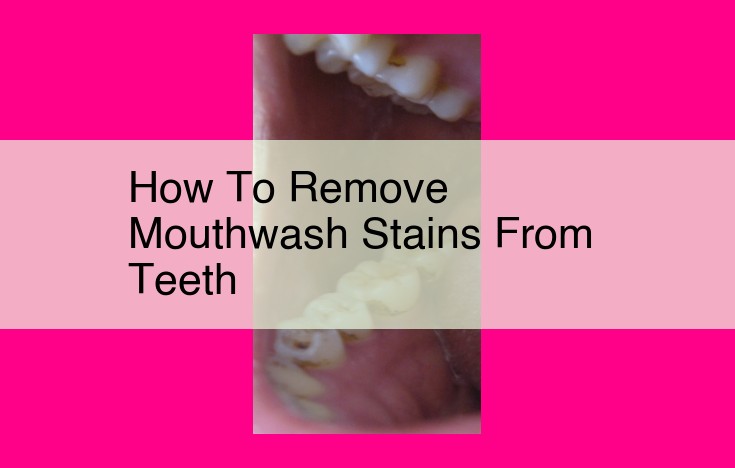Remove Mouthwash Stains: Expert Tips For A Brighter Smile

To remove mouthwash stains, reduce usage and choose alcohol-free options. Rinse thoroughly with water after using mouthwash to prevent stains from forming. Baking soda can also be used as a natural stain remover. Mix one teaspoon of baking soda with two teaspoons of water to create a paste. Apply the paste to the stained area and leave it on for five minutes. Then, brush your teeth as usual.
Understanding Tooth Stains: A Guide to Types and Causes
When we think of a bright, captivating smile, pristine white teeth often come to mind. But sometimes, unwanted stains can dim that pearly glow. Understanding the nature of tooth stains is the first step towards restoring your dazzling smile.
Extrinsic vs. Intrinsic Stains
Tooth stains can be classified into two primary categories: extrinsic and intrinsic. Extrinsic stains originate on the surface of the teeth, caused by external factors such as food, drinks, and certain habits. Conversely, intrinsic stains penetrate deep into the tooth structure, resulting from internal factors like trauma, medications, or genetic conditions.
Common Extrinsic Stains: The Culprits Behind Discoloration
Among the most common types of extrinsic stains are:
- Coffee, Tea, and Red Wine: These beverages contain potent tannins and chromogens, which can adhere to the tooth surface and cause yellow or brown discoloration.
- Tobacco: Nicotine and tar from cigarettes and cigars leave unsightly yellow stains on teeth.
- Chlorhexidine Mouthwashes: While effective against bacteria, chlorhexidine can bind to proteins on the tooth surface, leading to brown or yellow stains.
Contributing Factors: Unveiling the Causes of Stains
Beyond specific substances, several other factors contribute to tooth staining, including:
- Cetylpyridinium Chloride (CPC): This ingredient in some mouthwashes acts similarly to chlorhexidine, potentially causing stains.
- Alcohol: Alcohol in mouthwashes and certain foods dehydrates teeth, making them more vulnerable to stains.
- Essential Oils: Some essential oils, such as those found in peppermint or eucalyptus, contain compounds that can attach to teeth and cause discoloration.
Keeping Your Pearly Whites Stain-Free: A Comprehensive Guide to Prevention
It’s a common misconception that only certain foods and drinks can stain teeth. In reality, even everyday habits and products can contribute to discoloration, leaving us with less-than-dazzling smiles. To keep your teeth sparkling, understanding the culprits and implementing preventive measures is crucial.
Good Oral Hygiene: The Cornerstone of Stain Prevention
Establishing a solid oral hygiene routine is the foundation of stain prevention. Regular brushing and flossing remove plaque and bacteria, the breeding ground for stains. Use fluoride toothpaste to strengthen your teeth and rinse with water after every meal or snack to wash away potential staining agents.
Natural Remedies: Nature’s Tooth-Whitening Arsenal
Nature offers a range of gentle and effective remedies that can help brighten your teeth and fight stains. Baking soda, known for its abrasive properties, can remove surface stains. Hydrogen peroxide, a natural bleach, can also whiten teeth over time. Apple cider vinegar and lemon juice contain acids that can dissolve stains and restore your smile’s radiance. However, it’s important to use these remedies in moderation to avoid damaging tooth enamel.
Managing Tooth Stains
Professional Teeth Whitening Treatments
If home remedies and over-the-counter products fail, consider professional teeth whitening treatments performed by your dentist. These treatments often involve stronger bleaching agents and specialized techniques to achieve more dramatic results.
*In-office Whitening:*
The dentist applies a high-concentration whitening gel directly to your teeth for a short duration. This method provides immediate, noticeable results.
*Custom Trays and Home Whitening:*
Your dentist creates custom-fitted trays that you fill with a lower-concentration whitening solution. You wear the trays for several hours each day over a period of weeks or months. This option is less expensive than in-office whitening but takes longer to show results.
Over-the-Counter Stain Removers
While professional treatments offer significant results, over-the-counter (OTC) stain removers can provide a cost-effective solution for mild stains. These products typically contain mild bleaching agents or abrasives to remove surface stains.
*Carbamide Peroxide Gels and Strips:*
OTC whitening gels and strips contain carbamide peroxide, which breaks down into hydrogen peroxide, a bleaching agent. These products are effective in removing extrinsic stains.
*Abrasive Toothpaste:**
Toothpastes with mild abrasives, such as sodium bicarbonate (baking soda), can gently scrub away surface stains. However, excessive use can damage tooth enamel.
Strategies to Reduce Mouthwash Use
To minimize mouthwash-related stains, consider these strategies:
*Limit Use:**
Reserve mouthwash use for necessary occasions, such as after meals or when traveling.
*Choose Alcohol-Free Mouthwashes:**
Opt for mouthwashes that do not contain alcohol, as alcohol can contribute to staining. Look for alcohol-free mouthwashes with ingredients like cetylpyridinium chloride or essential oils.
*Rinse Thoroughly with Water:**
After using mouthwash, rinse your mouth thoroughly with water to remove any residual staining agents.